Introduction
The Karawanken/ Karavanke Mountains comprise diverse sedimentary, igneous and metamorphic rocks of Ordovician to Miocene age, and were uplifted during the late Caledonian, Variscan and Alpine orogenic cycles. The mountain ridges between Mežica and Slovenj Gradec were investigated geologically by the Austro-Hungarian geologists Marko Vincenc Lipold and Friedrich Teller in the second half of the 19th century (Lipold 1856; Teller 1888). They mostly documented Triassic and Jurassic beds with scare remains of ammonites, belemnites, bivalves, gastropods, brachiopods and microfossils.
The first Lower Cretaceous beds were recorded by Mioč and Šribar (1975) in a micropaleontological investigation of mostly (presumably) Jurassic beds. They established four basic calpionellid zones, namely: Crassiollaria, Calpionella (with C. alpina Lorenz, 1902; C. elliptica Cadisch, 1932), Calpionellopsis and Calpionellites, representing the time span from upper Tithonian to Valanginian.
The area of the Karawanken/ Karavanke UNESCO Global Geopark has been well investigated by geoscientists. Based on active research by experts in various fields, numerous research papers, articles, degree theses and monographs were written and published.
The Leše Geosite is in the southeastern part of the Karawanken/ Karavanke UNESCO Global Geopark, near Leše village above Prevalje in Slovenia. On the northern slope of Jankovec hill, local people opened a small quarry in Lower Cretaceous beds right by the forest road near Kresnik farmhouse, and south of the village (Figs. 1, 2).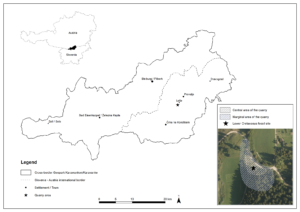
Figure 1. Central (quarry) and marginal area with Lower Cretaceous beds near Leše, Prevalje, Slovenia.
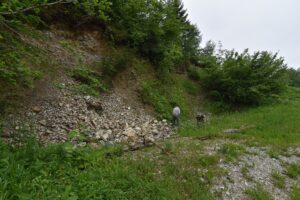
Figure 2. Geosite south of Leše near Prevalje; an small local quarry exposing Lower Cretaceous beds with recently discovered ammonites fauna. Photo: Matija Križnar.
Palaeontological Background of the Geosite
The local amateur paleontologists and mineral collectors Ivan Ocepek and France Krivograd were first to identify the extraordinary fossil site at Leše (Figs. 1, 2), a village mainly known for its Miocene coal mining tradition. Over the years, they collected approximately 50 specimens (Križnar & Ocepek 2018; Bricman 2019). The lithological and micropaleontological investigation of the Leše fossil site yielded rare and poorly preserved microfossils, mostly pelagic foraminifers (only determined: Calpionella alpina Lorenz, 1902) in a few meters thick succession of platy limestones (Fig. 2).
The most exciting discovery was in situ heteromorphic and monomorphic ammonites (Bricman 2019). These biostratigraphic indicators were the heteromorphic (Ancyloceratina) ammonites Himantoceras trinodosum Thieuloy, 1964 and Crioceratites cf. nolani Kilian, 1910. Himantoceras trinodosum is a species typical of the late Valanginian, having an open spiral coiled shell. Crioceratites cf. nolani is a species defined by the close (crioceraticonically) coiled shell, and it spans the stratigraphic interval from lower Hauterivian to lower Barremian (Fig. 3). The most similar ammonite faunas of Valanginian–Hauterivian age were described from the Northern Calcareous Alps of Austria (Lukeneder 2014) and the Dolomites (Puez area) in Italy (Lukeneder & Aspmair 2006).
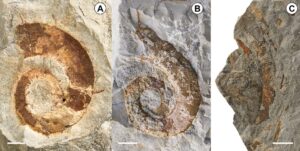
Figure 3. Valanginian and Hauterivian heteromorphic ammnonites (Ancyloceratina) from the Leše locality in the Karawanken/ Karavanke UNESCO Global Geopark. A, B) Crioceratites cf. nolani (Kilian, 1910). C) Himantoceras trinodosum Thieuloy, 1964. Scale bars 10 mm. Specimens are stored in the collection of Mr. Ivan Ocepek. Photo: Matija Križnar.
The Valanginian-Hauterivian age of the Leše beds is confirmed by other ammonites like Spitidicus rotula Sowerby, 1827 and Olcostephanus (Jeannoticeras) jeannoti d'Orbigny, 1841 (Bricman 2019) with some remains of belemnites and aptychi (Fig. 4). This fossil site at Leše, is under continuing paleontological and geological investigation (geological mapping), with the aim of establishing more detailed stratigraphical results.
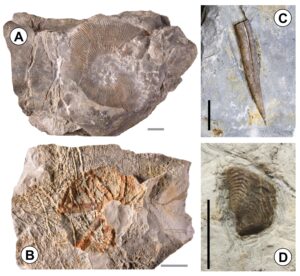
Figure 4. Other associated fossil from the Leše site in the Karawanken/ Karavanke UNESCO Global Geopark. Monomorphic ammnonites: A) Olcostephanus (Jeannoticeras) jeannoti d'Orbigny, 1841. B) Spitidiscus rotula Sowerby, 1827. C) Belemnite and D) Aptychus. Scale bars 10 mm. Specimens are stored in the collection of Mr. Ivan Ocepek. Photo: Matija Križnar (ammonites) and Ivan Ocepek (belemnite and aptychi).
Importance of the New Geosite
The Leše fossil site is important in several aspects:
- The first discovered locality for heteromorphic ammonites in Slovenia and in the cross-border Karawanken/ Karavanke UNESCO Global Geopark.
- A rare fossil site in Slovenia, containing Lower Cretaceous ammonites (and some other macrofossils).
- One of the newly discovered fossil geosites (Paleontological heritage sites) in the Karawanken/ Karavanke UNESCO Global Geopark.
- Representative example of good cooperation with local amateur paleontologists (local community), professional paleontologists (and geologists), geoheritage conservation and UNESCO Global Geopark.
Geotourism and Geotrail Potential
The large, 1067 square kilometers area of the cross-border Karawanken/ Karavanke UNESCO Global Geopark is characterized by exceptional geological structures and history. After ore and coal mining were abandoned, the area focused on its tourism potential, including a rich ethnographic heritage as well as geodiversity. Geotourism began to develop, including numerous geoproducts and programmes to introduce the key features of the Karawanken/ Karavanke UNESCO Global Geopark. Extraordinary fossils can be observed in both Infocentres as well as at local museums or exhibitions (Fig. 5). When hiking along the geotrails, visitors are introduced to many and various fossil deposits (exposed fossiliferous beds) at interpretive points.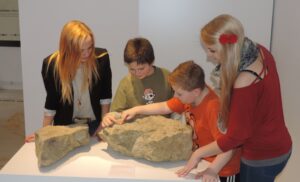
Figure 5. Exhibition in the infocenter of the Karawanken/Karavanke UNESCO Global Geopark in Bad Eisenkappel/ Železna Kapla where visitors can experience the world of fossils and other geological themes. Photo: Jürgen Lamprecht.
Within the Karawanken/Karavanke UNESCO Global Geopark, education and popularization of geoheritage are of utmost importance. Being aware of the potential vulnerability of paleontological sites, this geoheritage is being brought closer to both local people and visitors, by stimulating a sense of ownership as well as responsibility for preserving this heritage. Particular attention is given to training educators. Lectures, educational programs and/or field research days are being organized, where extra attention is paid to certain themes, according to the school year. In ten years of active training, educators were introduced to eight geological and non-geological contents, including fossils. This latter was titled Fossils – stories from the geological past. Trained educators thus became “our extended hand” in transferring knowledge, ideas and enthusiasm for geology, geological features as well as the need for their preservation to the youth and visitors to the Karawanken/ Karavanke UNESCO Global Geopark.
Protecting Geosites: Actions, Solutions and Limitations
As a member of the UNESCO Global Geoparks Network, the Geopark Karawanken/ Karavanke promotes protection and conservation of geosites in accordance with national laws and regulations. These geosites are assessed for their international, national (locality of national importance in Slovenia or Austria) and regional/local significance. They are classified according to their purpose (educational, tourism, scientific), type (geological, geomorphological, mine, hydro-geological, historic, botanical and/or zoological) and protection status (based on the Slovenian Nature Conservation Act written in the Official Gazette of the Republic of Slovenia (Ur. l. RS), No. 96/04 , 61/06, 8/10, 46/14, 21/18, 31/18 and 82/20), and Rules on the designation and protection of valuable natural features (Ur. l. RS No. 111/04, 70/06, 58/09, 93/10, 23/15 and 7/19), as well as the Austrian Bundesland Kärnten Law on Nature Protection (K-NSG), 2002). Until now, 48 geosites have been registered in the Geopark Karawanken/ Karavanke area, demonstrating the great geodiversity of the area which is exceptional at a global level (Poltnig & Herlec 2012).
In general, individual geosites in the Karawanken/ Karavanke UNESCO Global Geopark are not at great risk. The general protection regimes for geosites protected by law are mainly sufficient for their longterm conservation. Some geological sections are potentially at risk of being overgrown by vegetation and some mineral and fossil sites are at risk of over-collecting. Potentially threatened mineral and fossil sites are protected by access restriction (single localities are not accessible to the public, but only to scientific researchers). Karawanken/ Karavanke UNESCO Global Geopark ensures favorable conditions for potentially threatened profiles also by other milder conservation measures (e.g., adapted promotion, visitor management and education).
The Lower Cretaceous fossil site near Leše is the first heteromorphic ammonite site in Slovenia and the Karawanken/ Karavanke UNESCO Global Geopark. Based on the Rules on the designation and protection of valuable natural features (Ur. l. RS 111/04, 70/06, 58/09, 93/10, 23/15 and 7/19), cephalopod fossils are determined as valuable natural features if more than half of their shell or half of their cast is preserved. The heteromorphic ammonite site near Leše was evaluated according to established standards and criteria and declared as a valuable natural feature of national importance due to its uniqueness, rarity as well as importance for scientific research.
Conflict of Interest
The authors declare that there is no conflict of interest in their work.
